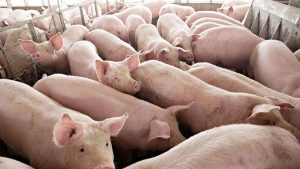Hog growers see supply of pork building up for year-end holidays

By Adrian H. Halili, Reporter
HOG GROWERS said on Thursday that the supply of pork is building up and will be sufficient to meet demand for the year-end holidays.
“We are assuring our public that… we have enough supply of pork,” National Federation of Hog Farmers, Inc. Chairman Chester Warren Y. Tan told reporters on the sidelines of an event organized by the Philippine Chamber of Agriculture and Food, Inc.
He added that pork demand will be primarily serviced by domestic production, augmented by some imports.
Pork imports during the eight months to August amounted to 450,360 metric tons (MT), according to the Bureau of Animal Industry (BAI). Imports of pork made up 49.6% of all meat imports during the period.
“We made sure that in the past two or three months we were prepared for the incoming December season,” Mr. Tan said.
Mr. Tan said that the prevailing farmgate price for live hogs ranged from P185 to P198 per kilo liveweight. This should translate to about P300 to P340 per kilogram in public markets.
In Metro Manila, a kilo of pork belly (liempo) was fetched between P330 and P400 per kilo, while pork shoulder (kasim) sold for P280 to P360, according to the Department of Agriculture’s (DA) price monitors as of Nov. 20.
Mr. Tan added that growth in hog production has been slow in the past two years, as industry output remains dampened by African Swine Fever (ASF).
“But what’s important is that there has been an increase in population and production,” he added.
During the third quarter, hog production declined 8% to 414,610 MT, according to the Philippine Statistics Authority.
The Philippines has recently logged a resurgence of ASF cases starting August, prompting the government to fast-track its limited vaccine rollout to commercial and small growers.
The DA has said that the increase in ASF cases in recent months was due to rains and tropical cyclone activity, which may have circulated contaminated water to the farms.
“For the past years, farmers have learned to control ASF, we have guidelines on how to minimize, how to protect our farms. Of course, there is no 100% assurance,” Mr. Tan added.
As of Nov. 8, 102 municipalities across 20 provinces had active ASF cases, the BAI reported.



![Photo of [B-SIDE Podcast] Concerns over the new CREATE MORE act](https://redstateinvestings.com/wp-content/uploads/2024/11/B-Side-Art-CREATE-MORE-Bill-300x300-y1q7zV-300x220.jpeg)
